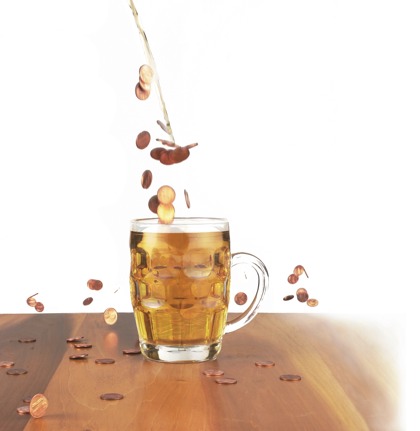Like it or not, taxes are a fact of life (or death, as some would say). They have been imposed on citizens by governments for centuries, and breweries and their beers have long been a favorite tap for government revenue.
Standard & Poor's DRI study released in January 2001 revealed that 44 percent of the cost of beer today is taxes alone.

(Kinsley Dey)
Egypt was the first civilization on record to tax beer. As European societies learned to make beer, the taxman dutifully followed. In the French city of Aix-la-Chapelle, the city council of 1271 mandated cutting off the right hand of brewers who failed to pay their beer taxes; taverns that didn’t pay were torn down. Beer historian Gregg Smith writes that in Hamburg in the late 16th century, there were over 1500 brewers; by 1698, due principally to high taxes, only 120 remained.
In London in the 1690s, gin was cheaper than beer because of lower taxes, which led to the social problems of excessive gin consumption depicted so vividly in Hogarth’s prints. The British government responded to the protests of reformers by raising the taxes on spirits, and beer soon regained its popularity among the drinking public.
In 1764, the first customs duty on beer and wine was imposed by the British on the American colonies. Following American independence, however, no taxes were levied on beer—a wise choice, since public outrage concerning unfair taxes helped fuel the American Revolution. But the tax-free status of beer was changed by none other than Abraham Lincoln, who issued a $1 per barrel tax on beer on July 1, 1862 to help pay for the Civil War (he also started the federal income tax). By 1919, the beer barrel tax had increased to just $6, and was only $9 in 1990, before being doubled the following year (it was later reduced to $7 per barrel for brewers making 2 million barrels or less).
Throughout history, businessmen have sought to avoid taxes, by legal means or otherwise. Savvy brewers have also found ways to reduce or dodge taxes—ways that have often changed the beers they made, sometimes in dramatic fashion. In fact, many of the beers we enjoy today were shaped by taxes as much as by taste or technology.
Pale Ale: Hotter Fires, Higher Taxes
Pale ale or bitter is a beer that needs no introduction to most craft brew drinkers. Yet this style (or family of styles) developed not just as a result of technology, but also because of taxes on its ingredients. The fabrication of coke from coal in 18th century Britain allowed maltsters to develop a high-heat dried pale malt that had no off-flavors as were common from wood-fired kilns. Taxes on coal, however, made production of this malt more expensive than the brown malt used for porters and stouts. As a result, the lighter colored “pale” ale that was produced from it was more expensive to make, and thus higher in price.
Since the resulting beers were more consistent and probably more reliably free of smoky or phenolic off-odors as well, pale ales were ideally suited for the export market—especially in their stronger and hoppier version as India pale ale.
Cheaper porter became a workingman’s brew. Perhaps the increased hoppiness of pale ales was a direct result of higher taxes on their production as well, since they were usually bottled for export, and needed more hops as a preservative.
When the export market for British ales shrank due to the Napoleonic Wars and restrictions on trade from high Russian tariffs, coal taxes were dropped, and the home market for pale ales expanded, while their alcohol strength was gradually reduced.









